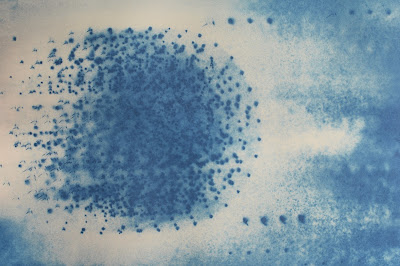Outpost 290722
TIME/ACTION/DIAGRAM.
Maya Deren's 1948 film, Meditation on Violence.
Two parabolic arcs describe three types of Chinese boxing in a single continuous movement.
The last portion of the film is printed in reverse motion.
DURATION
The not yet meets the already gone.
A fluid, flowing time is interwined with an experience of being where past, present and future merge. If one extreme of time is the experiential time of individual being, the other extreme is the abstract, anonymous, measured time of science.
Parallax, Steven Holl.
The Great Hall of Ascension can receive 10,000 people; its floor and ceiling are made of glass. It is intersected by the glass cages of nine elevators, each rising to its respective destination, traversing the other interiors with a discreet hiss. On the elevator shafts, electronic billboards announce different libraries. With fragments of texts, titles, names, songs descending in a continuous movement, the entire building seems supported by signs in a perpetual countdown to takeoff.
Rem Koolhaas.
Into The Frame Enters
The foreignness of the intimate or the violence and charity of perception.
R. Bruce Elder.
Kairos
The Movement and its Moment
Being Alive
Tim Ingold
Jannis Kounellis
At Castelvecchio, Sparpa embarked on a much more far-reaching idea of not only cleaning the building but attempting to clarify and expose the layers of history by selective excavation and creative demolition.
An Attitude to History, Carlo Scarpa.
It cannot be, it has gone!
They believe that we can do the same sort of work in the same spirit as our forefathers whereas for good or evil we are completely changed and we cannot do the work they did.
William Morris.
There is no stage at which human beings do not demarcate, beacon or sign their space, leaving traces that are both symbolic and practical.
The Production of Space, Lefebvre.
Autopoises and Cognition
The Realization of the Living
Humberto R. Maturana
Francisco J. Varela
We become observers through recursively generating representations of our interactions, and by interacting with several representations simultaneously we generate relations with the representations of which we can then interact and repeat this process recursively, thus remaining in a domain of interactions always larger than that of the representations.
We become self-conscious through self-observation, by making descriptions of ourselves (representations), and by interacting with our descriptions we can describe ourselves describing ourselves, in an endless recursive process.
For colour and against line and drawing.
Works identified as Expanded Cinema often open up questions surrounding the spectator's construction of time/space relations, activating the spaces of cinema and narrative as well as other contexts of media reception. In doing so it offers an alternative and challenging perspective on film-making, visual arts practices and the narratives of social space, everyday life and cultural communication.
The concept of pure colour in a monochrome.
I seek to put the spectator in front of the fact that the colour is an individual, a character, a personality. I solicit a receptivity from the observer placed before my works.
This permits him to consider everything that effectively surrounds the monochrome painting.
Thus he can impregnate himself with colour and colour impregnates itself in him.
Thus, perhaps, he can enter into the world of colour.
Yves Klein.
Colourspace that is not visible but within which one is impregnated.
Parallax and the free movement of the landscape through physical forms.
To resolve the material object into its spiritual substance.
Presenting Pure Pigment.
I did not like colours ground with oil. They seemed to be dead.
What pleased me above all was pure pigments in powder like the ones I often saw at the wholesale colour dealers.
They had a burst of natural and extraordinarily autonomous life.
Living and tangible colour material.
Magdalena Broska
Beuys Brown and Klein Blue.
Fire Pictures
Rain Sculptures
Air Architecture
Cosmogonies
Although it was a room painted totally in white, the artist spoke of an extraordinarily intense experience of blue: it was a true blue, the blue of the blue depths of space.
The demonstration of nothingness, the void of a white space.
Klein wanted to demonstrate the idea of a development from blue, a visible, tangible colour, via white to immaterialised blue.
There is an imaginary beyond, a pure beyond, one without a within, in which Bachelard's beautiful sentence resides: First there is nothing, then there is a deep nothing, then a blue depth.
Blue blood of sensibility
Bachelard/Shelley.
A wide variety of different expressions for the process of progressive dematerialisation.
The release of colour from the binding agent.
Work with dematerialised materials such as the elements fire, water, air and dust.
The term Expanded Cinema identifies a film and video practice which activates the live context of watching, transforming cinema's historical and cultural architectures of reception into sites of cinematic experience that are heterogeneous, performative and non-determined.
Narrative Exploration in Expanded Cinema, seeks to explore the various histories of expanded cinema and their impact on the question of narrative, space and time in experimental film and art practices.
Film/Expanded Cinema.
Temporal Spaces/Surfaces.
Transparency/Translucency, littoral and Phenomenal.
Mark Burry and Jane Burry
Prototyping for Architects.
Steven Holl
Parallax.
Designing buildings as serial prototypes.
Spatial Clocks/Theoretical Objects/Entanglements.
Materials imbue the wind-permeable wall with rich textile qualities.
The whole house acted as a prototype, not only showcasing the latest developments in green technology but also exploring at full scale, the performance of the house and the way in which people interacted with it.
The artists wanted to make the same gesture that many cultures make when marking the land through which they have passed, the placing of one stone on top of another to signal a route back.





























.jpg)







